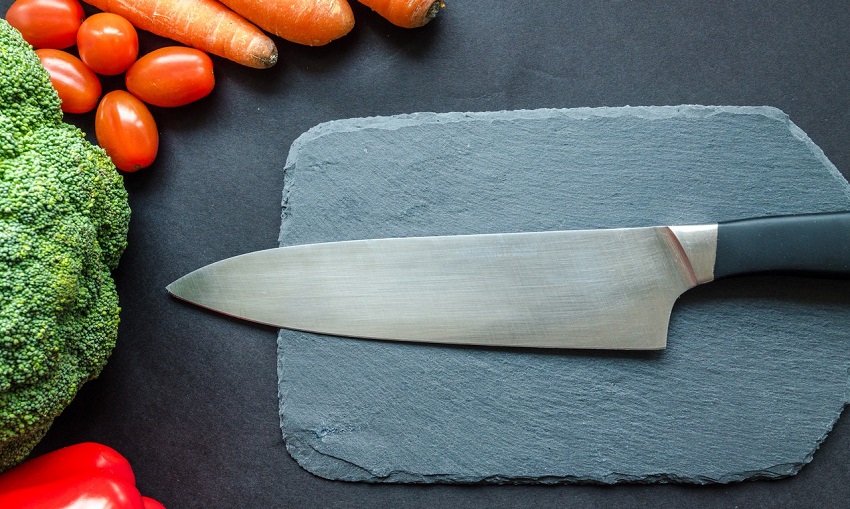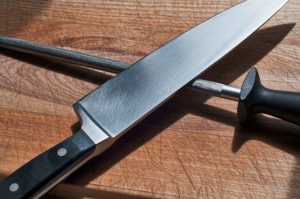
Most kitchens will have at least one chef’s knife, whether it’s a domestic or professional kitchen. Often, a chef’s knife will be able to last for many years providing it is taken care of and used for the correct purpose.
Even if this is the case, a knife will eventually need to be replaced, and there is then the problem of disposing of the knife in the correct way. Disposing of any type of knife is a serious issue, and there are laws governing the correct way to do this safely.
Get tips for buying your new chefs knife: The Complexities of a Simple Chef's Knife
Here are a few of the ways that you can retire your old knives, safely and in an environmentally friendly way.
Saving the Knife

Before you consider disposing of your chef’s knife, you should think about whether it can be saved and used again. Look carefully at the edge of the knife, can it be resharpened? This can be a quick and easy way to save the knife and extend its usefulness.
Perhaps if the handle is broken, it can be replaced? There are many companies that can fit another handle from whatever material you prefer.
Disposal in General Waste
Wherever possible, it is not advised to dispose of your chef’s knife in the general waste. However, if there is no alternative, then you should follow these steps.
-
Wrap up the knife
It is important that the knife is wrapped up well. The tip of the knife especially can be dangerous to those handling the waste, so ensure you wrap the knife in thick paper, bubble wrap, cardboard, styrofoam or other appropriate sheaths such as an edge guard.
-
Tape it up
Once the knife is wrapped up, you should tape it well with a strong tape such as parcel or carpet tape.
-
Protect the tip of the knife
The tip of the knife can puncture any wrapping if it is moved, so as an added precaution, try to protect it. You can use a piece of cork or rubber on the end before you wrap it to give it added safety.
-
Place knife in a suitable container
The wrapped knife needs to be placed in a tin or plastic pouch that cannot be punctured. This will not only protect those handling the knife, but it will also make it easier to see when in the rubbish.
-
Label the container
To ensure the safety of those handling the knife, you need to place a sticker on the container with the words ‘Caution: Sharp.’
-
Place where it can be seen
You can either place the container on the top of the refuse, where safe to do so, or make sure that those handling it aware that there is a knife in the refuse.
While disposing of your chef’s knife in the general waste might be the easiest thing to do, it might not be the best option. For example, there may be many metals in the knife that can make it a valuable material to someone who wants to buy it. This also means that you can earn some money to put towards a replacement knife.
For example, a blade that is made from high carbon steel such as 15N20 or 52100, will be able to fetch a good price because of the chromium and nickel content. However, other blades made from lower grades of steel won’t be able to fetch such a high price. That is why before you discard the knife, you should try to find out what type of steel it is made from.
Are you choosing the right replacement chef's knife?: Top 5 Knives you Need in your Commercial Kitchen
Recycling

It is also a good idea to mention it to the team at the recycling centre, so they are aware of the risk.
Selling
There are many companies that will offer you a good price for scrap metal. Again, this does depend on the composition of the knife, but even one of lesser quality steel will usually be worth something.
It is worth trying a few companies to see if you can get the best price, however, you need to be sure that the knife is being carried safely. It may also be a good opportunity to dispose of other knives or metal equipment at the same time as some companies fix their prices according to the weight of the metal you are selling.
Donating
If you don’t want to throw your knives away, or you think that they still have some use in them, then you can consider donating them.
There are many ways to donate your knives, but it is vital to ensure that you are following all the steps above regarding wrapping the knife before you hand it over.
One way to donate is to give it to a charity that can resell the knife. The knife has to be clean and blemish-free in many cases. It is also a good idea to contact the charity first to see if they are happy to take the knife.
You can also consider advertising the knife on a free selling site. However, you need to ensure that you are selling to someone old enough to buy it so that you are complying with the local laws.
These are just a few of the ways that you can dispose of your chef’s knives. Whatever route you take, always ensure you are thinking of the safety aspect first.


